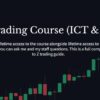Entry Mastery – ETM Trading
$199.00 Original price was: $199.00.$19.00Current price is: $19.00.
Dive deep into the world of strategic market positioning with Entry Mastery, a comprehensive guide designed to equip traders with the knowledge and skills to confidently enter and exit the market under diverse conditions. Discover how to understand market manipulation, identify institutional activity, and validate your entries for optimal trading performance.
Table of Contents
Entry Mastery

Entry Mastery promises to demystify the often complex world of market entries, offering a structured approach to understanding how sophisticated players manipulate the markets and how retail traders can avoid common pitfalls. Priced at $199, the course aims to provide practical insights and techniques that can be immediately applied to improve trading performance, regardless of market conditions.
Decoding Zonal System Manipulation
Zonal System Manipulation, the focus of the first and longest lecture, hints at a deeper understanding of market zones like support and resistance levels, or supply and demand zones. It’s not just about identifying these zones, but understanding how they are actively manipulated by larger market participants. This manipulation isn’t random; it’s often a calculated effort to trigger stop losses, accumulate positions at desired prices, or create artificial breakouts or breakdowns.
Imagine a scenario where a stock is hovering near a well-defined resistance level. Many retail traders will place their sell orders right at that level, anticipating a bounce. Now, picture a large institutional investor deliberately pushing the price slightly above the resistance, triggering those sell orders and effectively absorbing all the available supply. Once the supply is exhausted, they can reverse the price, sending it sharply lower and profiting from the failed breakout. This is zonal manipulation in action. Understanding this dynamic allows traders to not only avoid getting caught in such traps but potentially even to profit from them by anticipating the manipulator’s moves. It’s about seeing the market not as a static chart, but as a battleground where different factions are vying for control.
The importance of understanding zonal manipulation cannot be overstated. It’s the foundation for developing a more nuanced and strategic approach to trading. Instead of blindly following technical indicators or news events, traders can learn to interpret the underlying forces driving price movements. They can learn to identify the footprints of institutional activity and adjust their strategies accordingly. It’s about becoming a more informed and proactive participant in the market, rather than a passive observer.
Mastering the Purge/Stop Hunt Manual
The Purge/Stop Hunt Manual, the second lecture, is crucial because it directly addresses one of the most frustrating experiences for retail traders – the dreaded stop hunt. A stop hunt occurs when large players intentionally drive the price to trigger stop-loss orders clustered around specific price levels. This allows them to accumulate positions at better prices or shake out weak hands before a significant move in the opposite direction. Learning to identify and anticipate these stop hunts is essential for protecting capital and potentially even turning these manipulative moves into profitable opportunities.
Think of it this way: retail traders often place their stop-loss orders at obvious levels, such as just below a support level or just above a resistance level. These levels become magnets for institutional players who know where the liquidity is concentrated. They can use their vast resources to temporarily push the price to those levels, triggering the stop losses and scooping up the shares or contracts at the desired prices. The Purge/Stop Hunt Manual likely teaches traders how to recognize the patterns and indicators that precede these stop hunts, such as unusual order flow, increased volatility near key levels, or manipulation of short-term moving averages.
By understanding the anatomy of a stop hunt, traders can take several steps to protect themselves. First, they can avoid placing their stop-loss orders at obvious levels. Instead, they can use more sophisticated techniques, such as ATR-based stop losses or discretionary stops that are adjusted based on market conditions. Second, they can learn to identify the signs of an impending stop hunt and take proactive measures to reduce their exposure, such as reducing their position size or even temporarily exiting the trade. Finally, they can even attempt to profit from stop hunts by fading the initial move and anticipating the subsequent reversal. Effectively mastering the Purge/Stop Hunt Manual isn’t just about avoiding losses; it’s about turning market manipulation into a trading advantage.
Decoding Institutional Candles, Validated Entries, and FTC
The final lecture, covering Institutional Candles, Validated Entries, and FTC & More, dives into specific tools and techniques that traders can use to identify institutional activity, confirm the validity of trading opportunities, and refine their entry strategies. Institutional Candles likely refers to specific candlestick patterns that reveal the presence of significant buying or selling pressure from institutional investors. These patterns can provide valuable insights into market sentiment and potential future price movements.
For instance, a large bullish engulfing candle that occurs after a period of consolidation might indicate that institutional buyers are stepping in to accumulate the asset. Similarly, a bearish engulfing candle that occurs at a resistance level might signal that institutional sellers are looking to initiate short positions. By learning to identify and interpret these Institutional Candles, traders can gain a better understanding of the underlying forces driving price movements and make more informed trading decisions. Also, Validating entries moves beyond simply identifying potential setups and teaches traders to confirm the robustness of a trade before entering the market. This involves using a combination of technical indicators, price action analysis, and potentially even fundamental factors to assess the probability of success. The “FTC & More” section likely covers additional technical analysis concepts, trading strategies, or risk management techniques that further enhance the trader’s entry strategy toolkit.
The concept of validated entries is crucial for risk management and increasing the probability of successful trades. It’s about avoiding impulsive entries based on gut feelings or incomplete information. Instead, it involves a systematic and disciplined approach to confirming the validity of a trade before risking capital. For example, a trader might require that a potential entry meets several criteria, such as a break of a key resistance level, a confirmation from a momentum indicator, and a favorable risk-reward ratio. By implementing a validation process, traders can significantly reduce the number of losing trades and improve their overall profitability.
ETM Trading
ETM Trading, an abbreviation that could conceptually represent “Entry Technique Mastery,” extends beyond the basic understanding of market mechanics by providing a holistic approach to trade management, risk mitigation, and psychological resilience. It’s about developing a comprehensive trading strategy that integrates the lessons from Entry Mastery with other essential aspects of successful trading.
Integrating Entry Mastery with Broader Trading Strategies
Entry points are undeniably crucial, but they form only one piece of the overall trading puzzle. ETM Trading emphasizes that even the most precise entry can fail without a well-defined exit strategy, proper position sizing, and a clear understanding of the underlying market dynamics. Integrating Entry Mastery into a broader strategy involves considering factors such as market trend, volatility, and the trader’s own risk tolerance.
Consider, for example, a trader who has mastered the art of identifying stop hunts using the techniques learned in Entry Mastery. They might be tempted to jump into a trade immediately after spotting a potential stop hunt, anticipating a quick reversal and a profitable move in the opposite direction. However, without considering the overall market trend, they could be walking into a trap. If the market is in a strong downtrend, the stop hunt might simply be a temporary pause before the downtrend resumes. In this case, fading the stop hunt could lead to significant losses. ETM Trading advocates for a more holistic approach, encouraging traders to analyze the broader market context before making any trading decisions. This might involve assessing the trend on multiple timeframes, identifying key support and resistance levels, and monitoring economic news events that could impact the market. By integrating these factors into their trading strategy, traders can significantly improve their chances of success.
Furthermore, ETM Trading emphasizes the importance of adapting entry techniques to different market conditions. A strategy that works well in a trending market might not be suitable for a consolidating market. For example, in a trending market, traders might focus on entering on pullbacks or breakouts, using the trend as their guide. In a consolidating market, they might focus on range-bound strategies, buying support and selling resistance. By understanding the characteristics of different market conditions and adapting their entry techniques accordingly, traders can improve their profitability and reduce their risk.
Risk Management and Capital Preservation in ETM Trading
Effective risk management is the cornerstone of successful trading, and ETM Trading places a strong emphasis on protecting capital. This goes beyond simply setting stop-loss orders; it involves understanding position sizing, managing leverage, and constantly monitoring risk exposure. The techniques learned in Entry Mastery, such as identifying institutional candles and validating entries, can be powerful tools for managing risk, but they need to be applied within a comprehensive risk management framework.
Position sizing is a crucial aspect of risk management that involves determining the appropriate amount of capital to allocate to each trade. A common rule of thumb is to risk no more than 1% or 2% of total capital on any single trade. However, this rule can be adjusted based on factors such as the trader’s risk tolerance, the volatility of the asset being traded, and the probability of success of the trade. ETM Trading encourages traders to carefully consider these factors before determining their position size. For example, a trader who is highly risk-averse might choose to risk only 0.5% of their capital on each trade, while a trader who is more comfortable with risk might choose to risk 2%. Similarly, a trader who is trading a highly volatile asset might reduce their position size to compensate for the increased risk. ETM Trading also emphasizes the importance of using leverage responsibly. Leverage can amplify both profits and losses, so it’s crucial to understand the risks involved before using it. Traders should only use leverage if they have a clear understanding of the potential downside and are comfortable with the risk.
Beyond position sizing and leverage, ETM Trading advocates for continuous monitoring of risk exposure. This involves tracking the overall risk of the portfolio, identifying potential concentration risks, and adjusting positions as needed. For example, if a trader has a large portion of their capital invested in a single sector, they might consider diversifying their portfolio to reduce their exposure. Similarly, if a trader’s portfolio is highly correlated with a particular market index, they might consider hedging their exposure to protect against potential losses.
- Key elements of risk management in ETM Trading:
- Position Sizing: Determine the appropriate amount to invest in each trade based on risk tolerance and market volatility.
- Stop-Loss Orders: Utilize different types of stop-loss orders to protect capital from significant losses.
- Leverage Management: Use leverage cautiously, understanding its potential to amplify both gains and losses.
- Portfolio Diversification: Spread investments across various assets to reduce concentration risk.
- Risk Monitoring: Continuously track portfolio risk and adjust positions as needed.
The Psychology of Trading and ETM Trading
Trading is not just a technical skill; it’s also a psychological battle. Emotions such as fear, greed, and regret can cloud judgment and lead to impulsive decisions. ETM Trading recognizes the importance of developing a strong psychological foundation and provides strategies for managing emotions, maintaining discipline, and staying focused on the long-term goals. The techniques learned in Entry Mastery, such as validating entries and understanding market manipulation, can help to build confidence and reduce anxiety, but they need to be complemented by a solid psychological framework.
One of the key challenges in trading is managing fear. Fear can lead to paralysis, causing traders to miss out on profitable opportunities. It can also lead to impulsive decisions, such as closing positions prematurely or taking excessive risks to make up for losses. ETM Trading encourages traders to develop a proactive approach to managing fear, such as setting clear entry and exit rules, defining their risk tolerance, and focusing on the process rather than the outcome. By having a well-defined trading plan and sticking to it, traders can reduce the uncertainty and anxiety that can fuel fear.
Greed is another emotion that can derail traders. Greed can lead to overconfidence, causing traders to take on excessive risk and ignore warning signs. It can also lead to a reluctance to take profits, causing traders to hold on to winning positions for too long and ultimately lose them. ETM Trading emphasizes the importance of setting realistic profit targets, managing expectations, and being willing to take profits when they are available. By practicing discipline and avoiding the temptation to get greedy, traders can protect their gains and maintain a long-term perspective. Regret is an emotion that can linger long after a trading loss, causing traders to second-guess their decisions and lose confidence in their abilities. ETM Trading encourages traders to learn from their mistakes, but not to dwell on them. It’s important to accept that losses are a part of trading and to focus on improving future performance. By analyzing past trades and identifying areas for improvement, traders can turn their losses into learning opportunities.
Conclusion
Entry Mastery offers a potent toolkit for traders seeking to enhance their market entry strategies and navigate the complexities of market manipulation. By emphasizing zonal system understanding, purge/stop hunt identification, and meticulous validation of entries through institutional candle analysis, the course arms traders with a proactive approach to market engagement. When integrated with ETM Trading’s holistic principles of risk management, psychological resilience, and broad strategic thinking, traders can forge a comprehensive path toward sustained success, transforming market knowledge into consistent, profitable outcomes.
Sales Page:_https://etmtrading.podia.com/entry-mastery
Be the first to review “Entry Mastery – ETM Trading” Cancel reply
Related products
Forex & Trading
Forex & Trading
Forex & Trading
Forex & Trading
Forex & Trading
Forex & Trading












Reviews
There are no reviews yet.